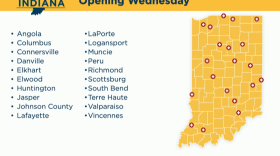Fewer cars on the road due to the COVID-19 pandemic has led to better air quality in many parts of the world. But state officials say it’s harder to tell what impact "Stay-At-Home" orders have had on air quality in Indiana overall.
While some air pollutants have gone down, others have gone up. Scott Deloney heads up the Indiana Department of Environmental Management’s Air Programs Branch.
He says nitrogen dioxide (NO2) — which mostly comes from cars — is going down because of "Stay-At-Home" orders. Since March 24, IDEM data shows NO2 emissions along I-70 are 41 percent lower than normal. At Indianapolis' Washington Park, they're 25 percent lower.
However, black carbon — pollution that comes from heavy-duty trucks — is going up.
“You’ve got Amazon fleet vehicles, UPS, federal express. And working from home, I can’t believe the amount of delivery vehicles that are in and out of the subdivision on a daily basis,” Deloney says.
Though regional energy experts say overall electricity demand is down, Deloney says we’re seeing more residential air emissions on cooler days.
“When temperatures cooled down, we saw a lot more home heating and a lot more people are staying home more hours of the day,” he says.
Deloney says Indiana has had the most challenges with controlling ground-level ozone and particle pollution, which tend to form in warmer weather. But he says some of the cooler, windy days we've been having makes it harder to track those kinds of pollutants.
Contact Rebecca at rthiele@iu.edu or follow her on Twitter at @beckythiele.
Indiana Environmental reporting is supported by the Environmental Resilience Institute, an Indiana University Grand Challenge project developing Indiana-specific projections and informed responses to problems of environmental change.





